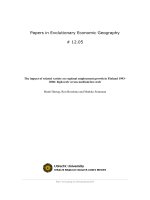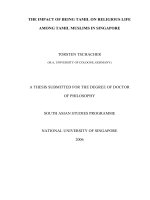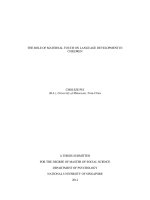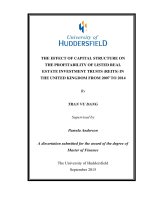Forest tends transformation in the course of invasion of Mikania micrantha kunth ex hbk. in Dilli reserve forest of assam - Emphasis on vegetation characters
Bạn đang xem bản rút gọn của tài liệu. Xem và tải ngay bản đầy đủ của tài liệu tại đây (1.03 MB, 10 trang )
Int.J.Curr.Microbiol.App.Sci (2018) 7(9): 1478-1487
International Journal of Current Microbiology and Applied Sciences
ISSN: 2319-7706 Volume 7 Number 09 (2018)
Journal homepage:
Original Research Article
/>
Forest Tends Transformation in the course of Invasion of
Mikania micrantha Kunth ex HBK. in Dilli Reserve Forest of
Assam - Emphasis on Vegetation Characters
Kuntala Neog Barua*, Protul Hazarika and Prodip Kr. Hazarika
Forest Ecology and Climate Change Division, Rain Forest Research Institute, P.Box No: 136,
Sotai, Jorhat-785001, Assam, India
*Corresponding author
ABSTRACT
Keywords
Vegetation characters,
Alteration, Mikania
micrantha invasion, Dilli
Reserve forest, Assam
Article Info
Accepted:
10 August 2018
Available Online:
10 September 2018
Changes of vegetation pattern of Dilli Reserve Forest under Sivasagar Forest Division,
Assam has been studied owing to invasion of aggressive smothering vine Mikania
micrantha during 2014-2017. Dipterocarpus retusus was the predominant element in the
upper canopy layer of natural forest site which grown gregariously in well drained alluvial
plains of the foothills of Patkai range having IVI of 13.19 followed by Mesua ferrea
(10.76), Artocarpus chama (10.63) and Vatica lanceaefolia (8.77). In contrary, the
Mikania infested forest areas top canopy strata was dominated by deciduous species of
short leafless period viz. Ficus hispida (IVI 14.47), Lagerstroemia speciosa (IVI 12),
Balakata baccata (11.49) etc. Tree density of infested site was recorded as 1276 /ha. and
in un-infested natural forest sites it was 2380/ha. Highest tree basal area of natural forest
indicated the dominance of more mature large trees of Dipterocarpus and Mesua. Seasonal
fluctuation of M. micrantha revealed that the weed vigorously invaded in the surrounding
forest edges and open canopy areas with highest population density (9.28 m2) in post
monsoon season. It alone constituted 18.01 % of herb layer contained the regenerating tree
seedlings and other herb species. Diversity index values were comparatively high in uninfested sites. Only 43.81% similarity was observed between un-infested and infested
forest sites. Smothering effect of fast growing vine have severe impact in regeneration and
seedling establishment of indigenous tree species mainly in periphery and open canopy
areas. They triggered the deciduous species usually, which altered the forest scenario in
near future.
Introduction
Biodiversity is essential for the ecosystem
function and stability (Singh, 2002).
Inventorisation of biodiversity is greatest
important to planning of forest management.
The forest diversity and dynamics was
determined by various environmental changes.
Distribution and abundance pattern of the
species influences the floristic diversity of any
forest site (Palit and Chandra, 2012). Species
richness of a forest is governed by a diverse
biotic and a biotic factors (Hustan, 1994).
Habitat destruction, over exploitation,
environmental pollution and alien invasion are
the main causes of biodiversity loss (UNEP,
1478
Int.J.Curr.Microbiol.App.Sci (2018) 7(9): 1478-1487
2001). Pimm (1986) stated that forest
community is changes due to habitat
fragmentation or invasion of foreign species.
The invasive species differ from native one,
on their requirements and more consumption
that may cause changes in soil structure,
profile, decomposition rate, moisture and
nutrient content. Therefore, exotic invasion is
a severe threat for conservation and
sustainable use of biodiversity.
Mikania micrantha Kunth ex HBK. is a very
fast growing perennial smothering vine of
Central and South American nativity, now a
ever-increasing menace to natural forests and
plantation sites in tropics and sub tropics
(Holm et al.,1977). In NE India, this species is
considered as one of the most troublesome
weeds in forest and non-forest areas and its
role in degrading productivity has been felt
since its introduction in the World War-II.
(Parker 1978 and Palit, 1981). Recently, the
open sunny patches of Dilli Reserve Forest of
upper Assam were severely infested by M.
micrantha which causing hazards to native
vegetation.
Various
anthropogenic
disturbances, forest fragmentation coupled
with such exotic invasion have posed direct
threat to the unique biodiversity of this forest.
Hence, the present study was undertaken to
evaluate the impact of M. micrantha on
floristic diversity and vegetation pattern in
Dilli Reserve Forest of Assam.
is comprised of 16.7 sq km (3108 ha.), with
elevation of 179 to 197 m above MSL. The
forest is in the track of alluvial formation over
Tertiary sand stone and shale, terrain is more
or less flat with a gentle slope from southeastern part. The vegetation of the forest is
semi evergreen and deciduous components
enriched with maximum biodiversity of the
undulating hill ranges of Arunachal Pradesh
assembly the formation of Assam Valley. Soil
sandy loam, pH ranges from 4.42 to 5.04 the
climate distinguished as humid sub-tropical
monsonic type. Average annual rainfall is
2191.28 mm received from the southwest
monsoon during June –Aug. Summer runs
from mid-April to August, July is the hottest
month and the maximum temperature ranges
between 19.5℃ to 33.38℃. Winter extends
from December to mid-February, minimum
temperature ranges between 8.2℃ to 25.79℃
and January is the coldest month. The average
relative humidity was recorded as 79.70%
during the study period and highest 98.84%
observed in the month of June.
Methodology
Field survey was carried out during the period
of 2014-2017 for floristic enumeration and
vegetation study. The Forest was divided into
two sites based on disturbance intensity of
invasive weed M. micrantha represented as
1. Un-infested site; 2. Infested site
Materials and Methods
Study site
Dilli Reserved Forest located in Sivasagar
district of Assam in the foothill of the Patkai
range between 2704’13.91” N to 2708’41.39”
N and 95017’25.40” E to 95021’56.07” E,
belongs to Assam Valley Tropical Wet
Evergreen Forest under the Eastern Himalayan
biodiversity hotspot (Figure 1). It is a part of
Jeypore-Dehing forest landscape and the area
Survey was carried out by randomly lined 25
quadrats of 10m x10m for tree species, one
hundred quadrats of 5m x 5m for
shrub/saplings and 125 quadrats of 1m x1m
for herb/seedlings in each site. The plants
having more than 6 ft. height were considered
as tree, plants having height of above 2.6 ft.
were regarded as shrubs and less than that
height were considered as herbs by following
Khan (1961). To determine the ecological
success of the dominants and co-dominants
1479
Int.J.Curr.Microbiol.App.Sci (2018) 7(9): 1478-1487
species in both the communities Importance
Value Index (IVI) was measured by following
Kershew (1973). Diversity index (Hʹ) and
concentration of dominance (CD) were
measured by Shannon and Weaver (1963) and
Simpson (1949) respectively for site
comparison. Species richness was measured
by Margalef Index (Margalef, 1958).
Evenness index and Equitability (Pielou
index) indicated that how evenly the
individuals are distributed over the different
species in the community. Sorenson and
Jaccard’s co-efficient and Motyka’s index
(Magurran, 1988) were used to calculate the
similarity co-efficient for the species among
the sites.
The plants were identified with the help of
local floras (Hooker, 1872-1897; Kanjilal et
al., 1934-40; Hajra & Jain, 1994, Shukla, 1996
and Chowdhury, 2005) and by consulting
Herbaria of Botanical Survey of India, Eastern
Regional Centre, Shillong, Central National
Herbarium, Kolkata. For nomenclature of the
taxa, recent Floras have been consulted along
with different plant data bases like
TROPICOS and PLANT LIST.
Results and Discussion
Floristic composition and phytosociology
Enumeration of vegetation pattern of Dilli
Reserve Forest indicated that a total of 406
plant species were representing to 283 genera
and 103 families belonging to phanerogams
and higher cryptogams. Among them trees
comprise 45 families 107 genera and 157
species. Euphorbiaceae is the dominant family
having 21 species followed by Lauraceae (12
species), Meliaceae (10) and Moraceae (10
species). Parthasarathy (2001) recorded 125
species of ≥30 cm diameter class in tropical
wet evergreen forest of Sengaltheri (Western
Ghats), which was somewhat comparable with
the studied forest. Shrubs were comprised of
70 species under 38 families and 53 genera.
179 species of herbaceous taxa was reported
from the forest site under 141 genera and 59
families. Floristic composition of the studied
forest has comparatively higher in other
tropical semi evergreen forest of this region.
Deb et al., (2011) studied the tree species
diversity of Namdapha National Park,
Arunachal Pradesh observed three distinct
canopy covers. Lauraceae, Dipterocarpaceae
and Euphobiaceae were the dominant family
of the forest that showed evidence of typical
lowland Evergreen Tropical Rainforest. Dilli
Reserve Forest exhibited more or less similar
type of vegetation structure and bear nearer
microclimates. Dipterocarpous retusus was
the predominant tree along with Mesua ferrea,
Artocarpus chama that grown gregariously on
well drained alluvial plains of the foothills of
the forest. Rich vegetative matter in the soil
supported the luxuriant growth of Dipterocarp
and Mesua.
The vegetation of the un-infested natural
forest site was identified as of Tropical Moist
evergreen and mixed semi-evergreen forest.
Trees are the predominant life form in the
forest ecosystem. The luxuriant DipterocarpMesua formation recognized the forests
ecologically and economically as a vital
position (Plate-1). Majestic growth of tree fern
and fern allies found along the damp shady
groove indicates the old land history of the
forests. Two ‘Least Concern' threatened
gymnosperm species Gnetum gnemon and G.
montanum in the IUCN Red List of 2011 were
distributed in the shady areas of the forest.
The trees were festooned with climbers, lianas
and epiphytic fern as well as orchids. Some of
the tree species found in the forest comes
under IUCN red list high risk categories viz.
Dipterocarpous
retusus,
Ailanthus
integrifolia, Michelia nilagirica, Garcinia
indica. Mangifera sylvatica. Wild Musa
species viz. Musa acuminate, M. bulbisiana
and M. rosacea were the dominant features
1480
Int.J.Curr.Microbiol.App.Sci (2018) 7(9): 1478-1487
formed bunch in the damp forest grove and
swamp areas along with thickets of Calamus
species. In the upper canopy layer of natural
forest site D. retusus was the leading species
having IVI of 13.19 followed by Mesua ferrea
(10.76), Artocarpus chama (10.63), Vatica
lanceaefolia (8.77). Highly populated
seedlings and Saplings of D. retusus, M.
ferrea, A. chama and Magnolia hodgsonii
were intermingled with them. Creation of gaps
and consequent reduction of canopy cover
favoured the growth of invasive species. In the
Mikania infested forest areas top canopy strata
was predominated by deciduous species of
short leafless period such as Ficus hispida
(IVI 14.47), Lagerstroemia speciosa (IVI 12),
Balakata baccata (11.49) (Figure 2).
Tree fern species Cyathea spinulosa (IVI
43.30) was the dominant species in shrub
strata in natural forest site along with Leea
asiatica (IVI 36.78) and Musaenda
roxburghii (IVI 23.90). Whereas, in infested
forest site Croton caudatus (IVI 51.12),
Combretum acuminatum (IVI 29.52), Litsea
salicifolia (IVI 25.58) and Chromolaena
odorata (IVI 24.05) were the major element in
the site. Phytosociological study in herbaceous
taxa revealed that Abacopteris lahimpurensis
(IVI 46.07), Schoenoplectilla juncoides (IVI
35.38), Selaginella biformis (IVI 19.32) were
prominant in the humid forest floor mix
together with highly occupied seedlings of D.
retusus and M. ferrea. On the other hand, in
infested forest site M. micrantha (IVI 64.44)
expressed highest dominancy along with
Oplismenus burmannii (IVI 14.03) and
Spermacoce hispida (IVI 13.21) (Figure 2).
Variation of tree density and basal areas of
infested and un-infested forest sites were quite
prominent. Tree density of infested site was
recorded as 1276 /ha. and in un-infested
natural forest sites it was 2380/ha. Highest
basal area of the trees in natural forest site
indicated the dominance of more mature old
large trees of Dipterocarpus and Mesua
formation (Figure 3).
Fig.1 Map of Dilli Reserve Forest
1481
Int.J.Curr.Microbiol.App.Sci (2018) 7(9): 1478-1487
Fig.2 Importance Value Index of top ten species in different strata level
1482
Int.J.Curr.Microbiol.App.Sci (2018) 7(9): 1478-1487
Fig.3 Comparative study of tree density and basal area of infested and un-infested forest sites
Fig.4 Seasonal changes of population density and IVI of Mikania micrantha
1483
Int.J.Curr.Microbiol.App.Sci (2018) 7(9): 1478-1487
Plate.1 Glimpses of Dilli Forests Reserve
A
B
C
D
E
F
A. Dipterocarp forest showing natural regeneration B. View of Dipterocarp-Mesua association C. Musa aurantica
G.Mann ex Baker D. Maclura cochinchinensis Corne. E. Magnolia hodgsonii Keng. F. Invasion of Mikania
micrantha in open canopy site
1484
Int.J.Curr.Microbiol.App.Sci (2018) 7(9): 1478-1487
Table.1 Different indices of Dilli Reserve Forest
Index
Species Diversity
Index (Hʹ)
Dominance
Margalef Index
Evenness Index
Pilou Index
Forest
site
Infested
Un-infested
Infested
Un-infested
Infested
Un-infested
Infested
Un-infested
Infested
Un-infested
Tree
3.92
4.59
0.02
0.01
10.05
17.70
0.96
0.97
2.21
2.23
Shrub
Pre monsoon
2.01
2.03
0.05
0.01
4.66
5.26
0.56
0.56
1.30
1.25
3.47
2.73
0.07
0.09
2.77
3.50
2.76
0.88
1.20
2.02
Herb
Monsoon Post monsoon
3.33
3.48
4.46
3.68
0.09
0.04
0.02
0.03
6.55
6.16
5.85
6.18
0.83
0.88
1.16
0.95
1.92
2.04
2.67
2.19
Winter
1.51
4.08
0.02
0.01
3.62
4.57
0.46
1.19
1.06
2.74
Table.2 Similarity co-efficient of Dilli Reserve Forest
Similarity Index
Sorenson co-efficient (Ss)
Jaccard’s co-efficient (Sj)
Motyka’s index
UN-I
0.3046
0.1797
43.81
UN: Un-infested
I: Infested
Study on seasonal fluctuation of M. micrantha
in infested forest sites revealed that the weed
vigorously invaded in the surrounding forest
edges and open canopy sites. Population size
of Mikania varied noticeably across the
seasons. Maximum population density (9.3
m2) was observed in monsoon season
followed by post monsoon season, winter
season and minimum value was recorded in
the pre monsoon season (2.88). Maximum IVI
values of M. micrantha were recorded in the
post monsoon season (IVI 64.44) followed by
winter season (IVI 56.90), pre monsoon
season (IVI 51.67) and monsoon season (IVI
48.90) respectively (Figure 4). Sufficient
wetness in soil with open sunlight is the
possible reasons for the higher density of
Mikania in infested forest site. The species
alone constituted 18.01 % of herb layer
contained all the regenerating tree seedlings
and other herb species in full growing season.
The first outbreak of the Mikania was
recorded in the month of March and gradually
the population was increased and attained
maximum range in the month of September to
November, that also supported by Puzari et
al., (2010).
Biological invasion is considered one of the
major threats to species diversity and
community structure that considered as the
primary cause for global biodiversity loss
(Porte et al., 2011). Rajwant et al., (2012)
studied the effect of M. micrantha invasion
and its connection with species richness and
soil respiration. They reported that species
richness was lower in the area invaded by
Mikania compared to not invaded areas and
seedling growth was suppressed in the
Mikania rhizosphere. Present observation
showed that the species richness value of all
the tree, shrub and herb strata were declined
1485
Int.J.Curr.Microbiol.App.Sci (2018) 7(9): 1478-1487
substantially in Mikania infested sites. Islam
et al., (2001) reported that in tropical semi
evergreen forest of Bangladesh, invasion of
Lantana camara influenced rapid turn down
of the species. Present study also showed
similar trend in invasion of Mikania, that
species diversity was significantly lowers in
infested sites and species composition was
also different. Knight (1975) reported that
diversity index was varied up to 5.40 for
tropical forest. Studied forest site belonged to
Tropical Wet Evergreen Forest and the values
of diversity index were found within the
ranges. Diversity pattern in the Mikania
infested and un-infested forest sites indicated
that the values of diversity index were
comparatively high in un-infested sites for
tree and herb community. Maximum diversity
index of herbaceous strata was observed in
the monsoon season (4.46) followed by
winter, post monsoon and minimum in pre
monsoon season (2.03). In the infested site the
value was high in post monsoon season
(3.48). The concentration of dominance
expressed negative correlation with diversity.
Considering the value of herb community the
dominance was found maximum in monsoon
season (0.09). Richness values were varied
from 3.62 to 6.55 in infested sites and 4.57 to
6.18 in un-infested sites considering the
different seasons. The value of evenness
index and equitability index exhibited no
significant difference in tree communities of
both the infested and un-infested forest (Table
1). Table 2 is associated with the results of
paired sites comparisons using binary
similarity coefficients. The assessment of
Sorenson’s similairity co-efficient is higher
than Jaccard’s co-efficient and the values for
Sorenson’s and Jaccard’s similarity coefficient were 0.3046 and 0.1797 respectively.
According to Motyka’s index only 43.81%
similarity was observed between un-infested
and infested forest sites as both the forest
were fairly distinct in their structural
compositions. The family Magnoliaceae,
Lauraceae, Dipterocarpaceae etc. were
dominated in un-infested natural site. On the
other hand in infested area family Moraceae,
Lyrthaceae, Rubiaceae and Euphorbiaceae
were dominated. Various anthropogenic
disturbances change the habitat suitability of
many species (Pandey and Shukla, 1999).
Occurrence
of different
Ficus
spp.,
L. speciosa, Trewia nudiflora, B. baccata etc.
in the open infested areas and forest
boundaries suggested their tolerance and a
wide ecological extent.
The overall observation revealed that invasion
of Mikania is highly negligible in dense forest
of un-infested site. Seedlings or saplings
recruitment of some evergreen high valued
species viz. D. retusus, M. ferrea, V.
lancaefolia, Ailanthus excelsa, Magnolia
champaca, M. griffithii, M. insignis, M.
montana, M. nilgirica etc. were prominent in
dense natural forest sites. The smothering
effect of this fast growing vine have severe
impact in regeneration and seedling
establishment of indigenous tree species
mainly in periphery areas and open canopy
sites. They triggered the deciduous species
usually, which was going to be altered the
forest scenarioin near future. Intensive
protection and maintaining close canopy
coverage in natural forest site providing deep
shade that may be a preventive precaution
against weed invasion drivered by M.
micrantha.
Acknowledgments
I would like to express my deep sense of
gratitude and sincere thanks to Director, Rain
Forest Research Institute, Jorhat for help and
support during the project duration. I am
grateful to the State Forest Department of
Assam, Divisional Forest Officer and the staff
of Sivasagar and Dibrugarh for permits to
work in the Reserve as well as their support
and co-operation.
1486
Int.J.Curr.Microbiol.App.Sci (2018) 7(9): 1478-1487
References
Hooker, J.D., 1872-97. Flora of British India
I to VII. Reeves and Co, London
Huston, M.A., 1994. Biological Diversity.
Cambridge University press, Cambridge
Islam, K.R., M.R. Ahmed, M.K. Bhuiyan and
Badruddin, A. 2001. Deforestation
effects on vegetative regeneration and
soil quality in tropical semi evergreen
degraded and protected forests of
Bangladesh. 12: 45-56.
Kanjilal, U.N., P.C. Kanjilal, De RN and Das,
A. 1934-40. Flora of Assam (in 4
volumes) Govt. of Assam, Shillong
Kershaw, K.K. 1973. Quantitative and
dynamic plant Ecology Edward Arnold
London Pp.308 Margalef, R. 1958.
Information theory in ecology. General
systematic. 3: 36-71.
Palit, D., S. Pal and Chanda, S. 2012.
Diversity and richness of plants in
Darjeeling Himalaya with an eye on
Gaddikhana forest beat, Senchal east
zone forest range, Derjeeling, Ind. J.
For. 35: 39-44.
Pandey, S.K. and Shukla, R.P.1999. Plant
diversity and community pattern along
the disturbance gradient in plantation
forest of sal (Shorea robusta Gaertn.)
Curr. Sci. 77: 814-818.
Parthasarathy, N. 2001. Changes in forest
composition and structure in three sites
of tropical evergreen forest around
Sengaltheri, Western Ghats. Curr. Sci.
80(3): 389-393.
Pimm, S.L. 1986 Community structure and
stability. In: M. Soul (ed) Conservation
Biology: the science of scarcity and
diversity.
Sinauer,
Sunderland,
Massachusetts, USA 309-329.
Shannon, C.E. and Weaver, W.1963. The
Mathematical
Theory
of
Communication University of Illinois
Press, Urbana.
Simpson, E.H. 1949. Measurement of
diversity. Nature: 163-688.
How to cite this article:
Kuntala Neog Barua, Protul Hazarika and Prodip Kr. Hazarika. 2018. Forest Tends
Transformation in the course of Invasion of Mikania micrantha Kunth ex HBK. in Dilli
Reserve Forest of Assam - Emphasis on Vegetation Characters. Int.J.Curr.Microbiol.App.Sci.
7(09): 1478-1487. doi: />
1487









